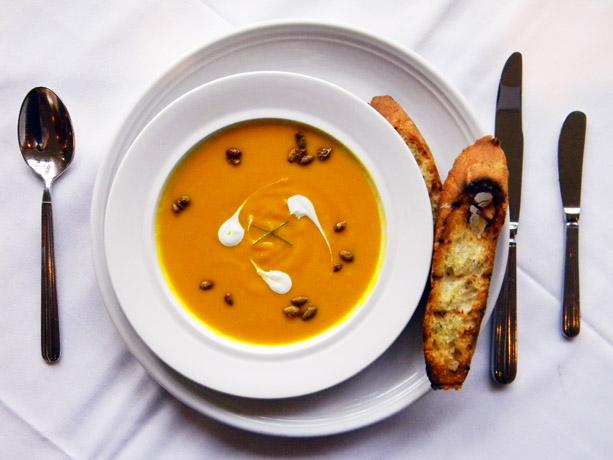“Mother nature is an artist herself, with a palette of colors that create the seasons,” says Chef Ris Lacoste. “She gives us the green vegetables of spring—asparagus, peas and spinach. Then summer brings the fiery reds and yellows of tomatoes, corn and peppers. And then those reds and yellows mellow into the sweet golden orange of fall. You just know the bright orange pumpkins are out there in the patch, waiting to be picked.”
Gastronomically speaking, pumpkins are the oft forgotten stepchildren tof the winter squash family. Butternut, acorn, hubbard and spaghetti squash frequent the markets and tables of seasonal eaters everywhere. But pumpkins are almost exclusively found at roadside pumpkin stands promoting Halloween, and their culinary potential is rarely tapped to its fullest extent. “We don’t eat the Jack-O-Lantern,” says Ris.
As it were, Halloween carving pumpkins, the most commonly grown and distributed variety of all winter squash, are not very good or flavorful, and that may be some of the reason why pumpkins have fallen off the epicurean radar. But anything you do with squash, says Ris, you can call pumpkin. “Talking pumpkin is talking winter squash, and vice versa,” she says. “There are many varieties of pumpkins and winter squash with subtle differences in flavor and texture. And finding your favorites is half the fun.”
Ris’ favorite pumpkin is the Rouge Vif d’Etampes, a beautiful French heirloom variety. Its color is a deep red-orange, with fat, pronounced ribs and a flat shape like a tire on its side. It bears a striking resemblance to the pumpkin that Cinderella’s fairy godmother turned into a horse-drawn carriage to get to the Prince’s ball. They are also quite delicious.
There are hundreds of species of pumpkins out there, so it’s important to know what to look for. Surprisingly, some of the best eating varieties are those tiny ornamental pumpkins sitting in the wicker basket in your living room. Though big, deep-ribbed field pumpkins are great for carving, their tough skins are hard to peel and their flesh is stringy and bland.
For cooking and baking, it’s better to go with smaller varieties with sweet, deep orange flesh and smooth texture. Baby Pam, Small Sugar Pumpkins, and New England Pie Pumpkins are good examples of round, small to medium size pie pumpkins. Most of these varieties have a bright orange skin and thick, straight stems. There are also more unusual varieties, such as the grayish-blue Jarradale pumpkin or the long, smooth crook-necked pumpkin.
“When discovering these different pumpkins or winter squash,” says Ris, “take note of their different densities, textures and flavors and see how different varieties work for different types of recipes.”
For example, a denser texture of pumpkin will work better for ravioli. “You don’t want moisture in ravioli,” says Ris. “The filling should be as dry as possible so as not to dampen the dough.”
Perhaps the biggest misfortune of the fate of the pumpkin is that it is so narrowly relegated to the job of pie filler. This is not to say that pumpkin pie is not entirely perfect—it is, Ris assures—but pumpkins have so much more potential. They make great breads and cakes, stews and chilis, waffles and pancakes, ravioli, gratins, and even pudding.
From firewood and chimney smoke, to crisp air and mulled cider, pumpkin invokes these autumnal aromas, no matter how you cook it. Pumpkins are generally sweet and savory, says Ris, allowing them to mix well with a dynamic range of combinations, like maple syrup and orange juice, or Parmesan cheese and sage. They take well to grilling, roasting, baking and frying. And they are exceptional in soups.
Pumpkin soup has innumerable international variations, from Chinese pumpkin soup with water chestnuts and shrimp, to Australian pumpkin soup with lemon, to Haitian pumpkin soup with beef, rice and nutmeg. Many of the North American Island and Central American countries use pumpkin in soups to unique and surprising results. Pumpkin pops up frequently in Mexican soups and stews, often topped with roasted pumpkin seeds, or “pepitas.”
To showcase the broad versatility of this favorite fall treat, Ris will be offering pumpkin soup and pumpkin ice-cream in her Foggy Bottom restaurant. “Its hot and cold, a starter and a dessert, sweet versus savory. You can do so much with pumpkins, and I thought this was a fun way to bookend it.”
The restaurant will also be featuring maple-walnut, apple spice and cranberry ice-creams, along with a variety of seasonally inspired soups. “It’s my ‘Soups and Scoops’ special,” she says with delight. “I really wanted bring together the tapestry of the fall harvest in a unique way. We don’t often think about it, but the reason we use these traditional, seasonal ingredients together is because they grow together. These flavors all play in the same seasonal sandbox, and it’s so much fun to shuffle around their responsibilities.”
Enjoy these pumpkin soup and ice-cream recipes on your own, or stop by RIS to give them a whirl.
RIS Pumpkin Ice-Cream
By Pastry Chef Chris Kujala
2 cups heavy cream
2 cups half and half
1 cup egg yolks
4 oz. sugar
4 oz. dark brown sugar
1 tsp ground cinnamon
1/8 tsp ground nutmeg
1/2 tsp ground ginger
1/8 tsp ground clove
1/4 tsp ground allspice
1/4 tsp salt
2 cup pumpkin puree
Put the cream, half and half, white sugar and all the spices in a medium sauce pot. Place over medium heat. Bring just to a boil—not a rolling boil. Remove from heat. In a large bowl whisk together the egg yolks, dark brown sugar and salt. Whisk about a minute to dissolve the sugar. Slowly whisk in the hot cream mixture to the yolk mixture. Whisk in the pumpkin puree. Strain with a fine mesh strainer. Chill over ice bath. Freeze in an ice-cream maker. Note: spices can and should be adjusted to taste.
RIS Pumpkin Patch Soup
By Sous Chef Jed Fox
1/2 stick of butter
1 cup diced white onion
1 cup peeled, cored, diced sweet apple
1 cup peeled, diced carrot
1 cup peeled, diced and roasted sweet potato
3 cups peeled, seeded, diced and roasted pumpkin
Dark rum
6 cups chicken or vegetable stock
2 cups heavy cream
1/4 cup pure maple syrup
Salt and cayenne pepper to taste
In a large saucepot over medium-high heat, melt the butter. Add the onion, apple and carrot, and cook until the onion is caramelized, about ten minutes. Stir in the roasted sweet potato and pumpkin and deglaze with a healthy splash of rum. Let cook another five minutes, then add the chicken stock and bring to a boil. Simmer until all of the vegetables are cooked through and tender, ten to fifteen minutes. Puree vegetables in a blender or food processor. Add cream, maple syrup, salt and cayenne pepper to taste. Just before serving, return to the pot and bring to a simmer. If soup is too thick, adjust with warm water, taste again for seasoning and adjust if necessary.
- Pumkin Soup | By Ari Post




